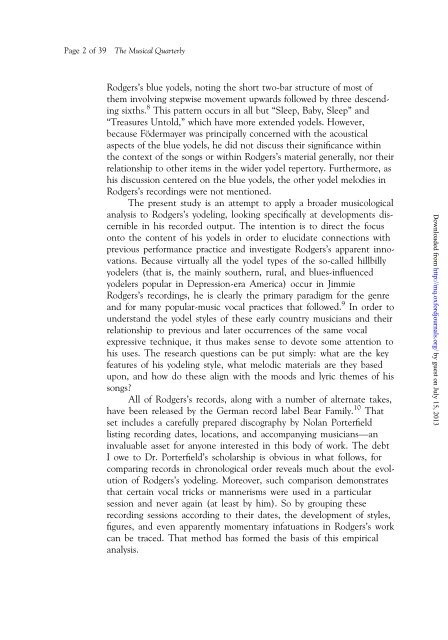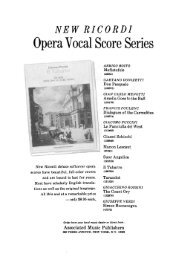Jimmie Rodgers and the Semiosis of the Hillbilly ... - Musical Quarterly
Jimmie Rodgers and the Semiosis of the Hillbilly ... - Musical Quarterly
Jimmie Rodgers and the Semiosis of the Hillbilly ... - Musical Quarterly
You also want an ePaper? Increase the reach of your titles
YUMPU automatically turns print PDFs into web optimized ePapers that Google loves.
Page 2 <strong>of</strong> 39 The <strong>Musical</strong> <strong>Quarterly</strong><br />
<strong>Rodgers</strong>’s blue yodels, noting <strong>the</strong> short two-bar structure <strong>of</strong> most <strong>of</strong><br />
<strong>the</strong>m involving stepwise movement upwards followed by three descending<br />
sixths. 8 This pattern occurs in all but “Sleep, Baby, Sleep” <strong>and</strong><br />
“Treasures Untold,” which have more extended yodels. However,<br />
because Födermayer was principally concerned with <strong>the</strong> acoustical<br />
aspects <strong>of</strong> <strong>the</strong> blue yodels, he did not discuss <strong>the</strong>ir significance within<br />
<strong>the</strong> context <strong>of</strong> <strong>the</strong> songs or within <strong>Rodgers</strong>’s material generally, nor <strong>the</strong>ir<br />
relationship to o<strong>the</strong>r items in <strong>the</strong> wider yodel repertory. Fur<strong>the</strong>rmore, as<br />
his discussion centered on <strong>the</strong> blue yodels, <strong>the</strong> o<strong>the</strong>r yodel melodies in<br />
<strong>Rodgers</strong>’s recordings were not mentioned.<br />
The present study is an attempt to apply a broader musicological<br />
analysis to <strong>Rodgers</strong>’s yodeling, looking specifically at developments discernible<br />
in his recorded output. The intention is to direct <strong>the</strong> focus<br />
onto <strong>the</strong> content <strong>of</strong> his yodels in order to elucidate connections with<br />
previous performance practice <strong>and</strong> investigate <strong>Rodgers</strong>’s apparent innovations.<br />
Because virtually all <strong>the</strong> yodel types <strong>of</strong> <strong>the</strong> so-called hillbilly<br />
yodelers (that is, <strong>the</strong> mainly sou<strong>the</strong>rn, rural, <strong>and</strong> blues-influenced<br />
yodelers popular in Depression-era America) occur in <strong>Jimmie</strong><br />
<strong>Rodgers</strong>’s recordings, he is clearly <strong>the</strong> primary paradigm for <strong>the</strong> genre<br />
<strong>and</strong> for many popular-music vocal practices that followed. 9 In order to<br />
underst<strong>and</strong> <strong>the</strong> yodel styles <strong>of</strong> <strong>the</strong>se early country musicians <strong>and</strong> <strong>the</strong>ir<br />
relationship to previous <strong>and</strong> later occurrences <strong>of</strong> <strong>the</strong> same vocal<br />
expressive technique, it thus makes sense to devote some attention to<br />
his uses. The research questions can be put simply: what are <strong>the</strong> key<br />
features <strong>of</strong> his yodeling style, what melodic materials are <strong>the</strong>y based<br />
upon, <strong>and</strong> how do <strong>the</strong>se align with <strong>the</strong> moods <strong>and</strong> lyric <strong>the</strong>mes <strong>of</strong> his<br />
songs?<br />
All <strong>of</strong> <strong>Rodgers</strong>’s records, along with a number <strong>of</strong> alternate takes,<br />
have been released by <strong>the</strong> German record label Bear Family. 10 That<br />
set includes a carefully prepared discography by Nolan Porterfield<br />
listing recording dates, locations, <strong>and</strong> accompanying musicians—an<br />
invaluable asset for anyone interested in this body <strong>of</strong> work. The debt<br />
I owe to Dr. Porterfield’s scholarship is obvious in what follows, for<br />
comparing records in chronological order reveals much about <strong>the</strong> evolution<br />
<strong>of</strong> <strong>Rodgers</strong>’s yodeling. Moreover, such comparison demonstrates<br />
that certain vocal tricks or mannerisms were used in a particular<br />
session <strong>and</strong> never again (at least by him). So by grouping <strong>the</strong>se<br />
recording sessions according to <strong>the</strong>ir dates, <strong>the</strong> development <strong>of</strong> styles,<br />
figures, <strong>and</strong> even apparently momentary infatuations in <strong>Rodgers</strong>’s work<br />
can be traced. That method has formed <strong>the</strong> basis <strong>of</strong> this empirical<br />
analysis.<br />
Downloaded from<br />
http://mq.oxfordjournals.org/ by guest on July 15, 2013







